In the United Kingdom, six majestic eagle species grace the skies, each contributing to the rich avian tapestry of the region.
From the iconic White-tailed Eagle, symbolizing successful reintroduction efforts, to the Golden Eagle, embodying the rugged landscapes, and the Sea Eagle, soaring along the coastal realms, the UK boasts a diverse array of these formidable raptors.
Join us in this exploration as we unravel these six eagles’ distinct characteristics, habitats, and conservation stories.
From their impressive wingspans to their crucial roles in maintaining ecological balance, these eagles showcase the delicate harmony between wildlife conservation and preserving avian splendour in the British Isles.
6 Eagles in the UK
Let us start on a journey to understand the lifestyles, behaviours, and conservation status of these magnificent eagles, showcasing the diverse tapestry of these iconic birds across the globe:
1. White-tailed Eagle
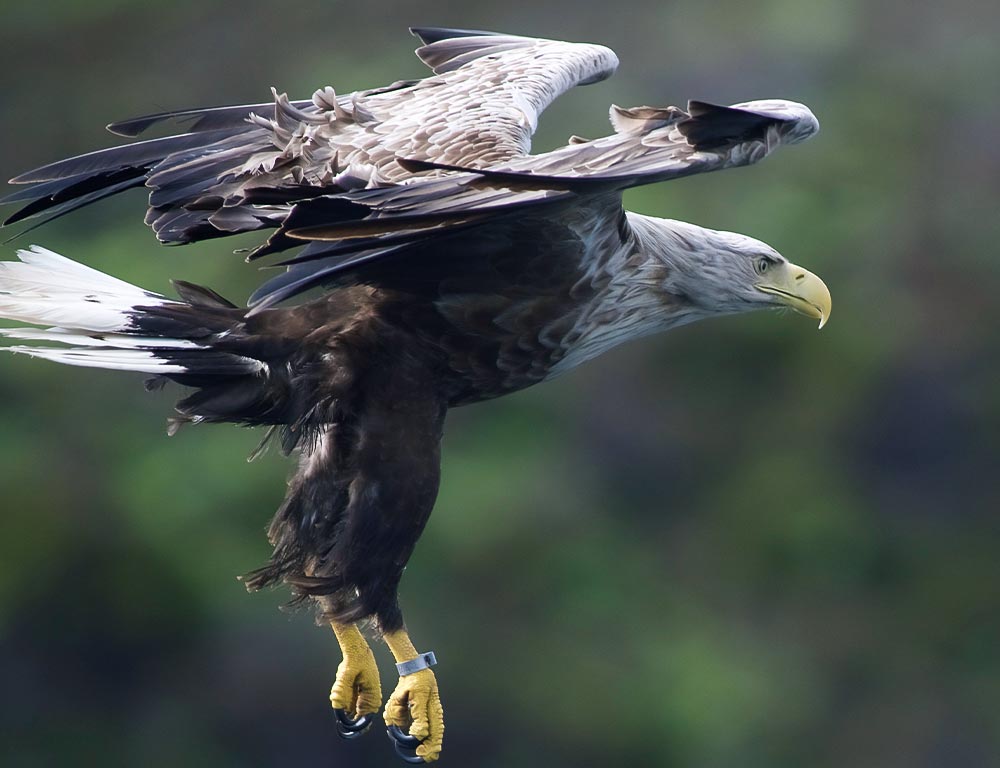
- Scientific Name: Haliaeetus albicilla
- Population: Approximately 106 pairs in the UK (as of the last count in 2018)
- Life Span: Up to 25 years
- Size: 66-94 cm (26-37 inches)
- Weight: 3-5 kg (6.6-11 lbs)
- Food: Fish, seabirds, waterfowl, and carrion
- Wingspan: 200-245 cm (79-96 inches)
- Status: Reintroduced species with a recovering population
The White-tailed Eagle, also known as the sea eagle, is a majestic bird of prey that has been successfully reintroduced to the UK after being extinct for several decades.
With its impressive wingspan and powerful build, it is primarily a coastal species, favouring areas with access to large bodies of water.
White-tailed eagles are skilled hunters who use their keen eyesight to spot fish near the water’s surface and swoop down to snatch them with their powerful talons. They also scavenge for carrion and may target seabird colonies.
These eagles are known for their elaborate courtship displays, which involve breathtaking aerial acrobatics. Their nests, often situated in coastal cliffs or large trees, are substantial structures built over several years.
White-tailed eagles are territorial birds fiercely defending their nesting sites. With ongoing conservation efforts, the population of these iconic eagles in the UK is gradually rebounding.
2. Golden Eagle

- Scientific Name: Aquila chrysaetos
- Population: Estimated around 500 breeding pairs in the UK
- Life Span: Up to 30 years
- Size: 75-90 cm (30-35 inches)
- Weight: 3-6.5 kg (6.6-14.3 lbs)
- Food: Mainly small mammals and birds, occasionally carrion
- Wingspan: 190-230 cm (75-91 inches)
- Status: Resident breeding species
The Golden Eagle is a formidable bird of prey, well adapted to the rugged landscapes it calls home.
With its impressive wingspan and keen eyesight, this species is a master of soaring flight. Golden eagles are found in mountainous and upland areas, building large nests on cliffs or rocky ledges.
These eagles are known for their hunting prowess, preying on small mammals and birds. Their powerful talons and beak enable them to capture and subdue prey.
Golden eagles are monogamous and form strong bonds with their mates. They engage in elaborate courtship displays, including soaring together in the sky and performing impressive aerial acrobatics.
Despite their impressive hunting abilities, golden eagles face threats such as habitat loss and illegal persecution. Conservation efforts are crucial to ensuring the continued presence of these majestic birds in the UK.
3. Sea Eagle
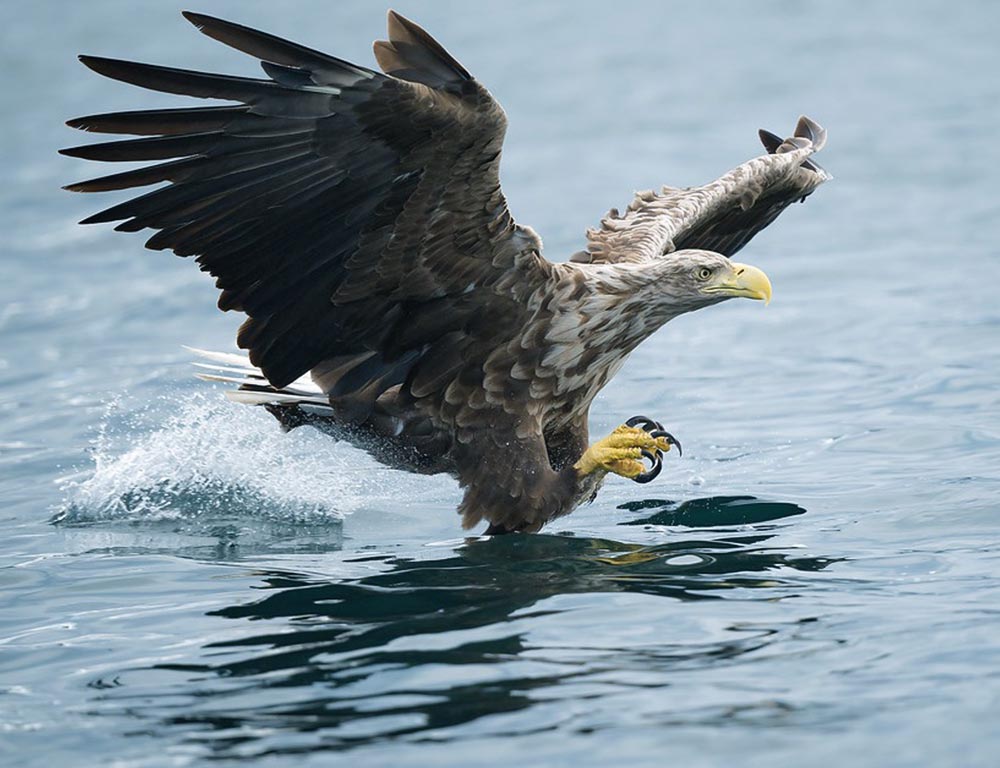
- Scientific Name: Haliaeetus spp. (typically referring to the White-tailed Eagle or the Steller’s Sea Eagle)
- Population: Approximately 106 pairs of White-tailed Eagles in the UK (as of the last count in 2018)
- Life Span: Up to 25 years
- Size: 66-94 cm (26-37 inches)
- Weight: 3-5 kg (6.6-11 lbs)
- Food: Fish, seabirds, waterfowl, and carrion
- Wingspan: 200-245 cm (79-96 inches)
- Status: Reintroduced species with a recovering population
The term “Sea Eagle” often refers to the White-tailed Eagle and the Steller’s Sea Eagle, both powerful and impressive birds.
The White-tailed Sea Eagle, as described earlier, is a reintroduced species in the UK, thriving in coastal areas. On the other hand, the Steller’s Sea Eagle is not native to the UK but is a massive bird native to coastal northeastern Asia.
Both sea eagles share a similar lifestyle, with a preference for coastal habitats and a diet primarily consisting of fish. They are renowned for their impressive hunting skills, diving from the sky to snatch fish from the water’s surface.
Sea eagles are also opportunistic scavengers, feeding on carrion and occasionally preying on waterfowl and seabirds. Conservation efforts have been crucial in restoring their populations in the UK, highlighting the importance of protecting their coastal habitats.
4. Bald Eagle
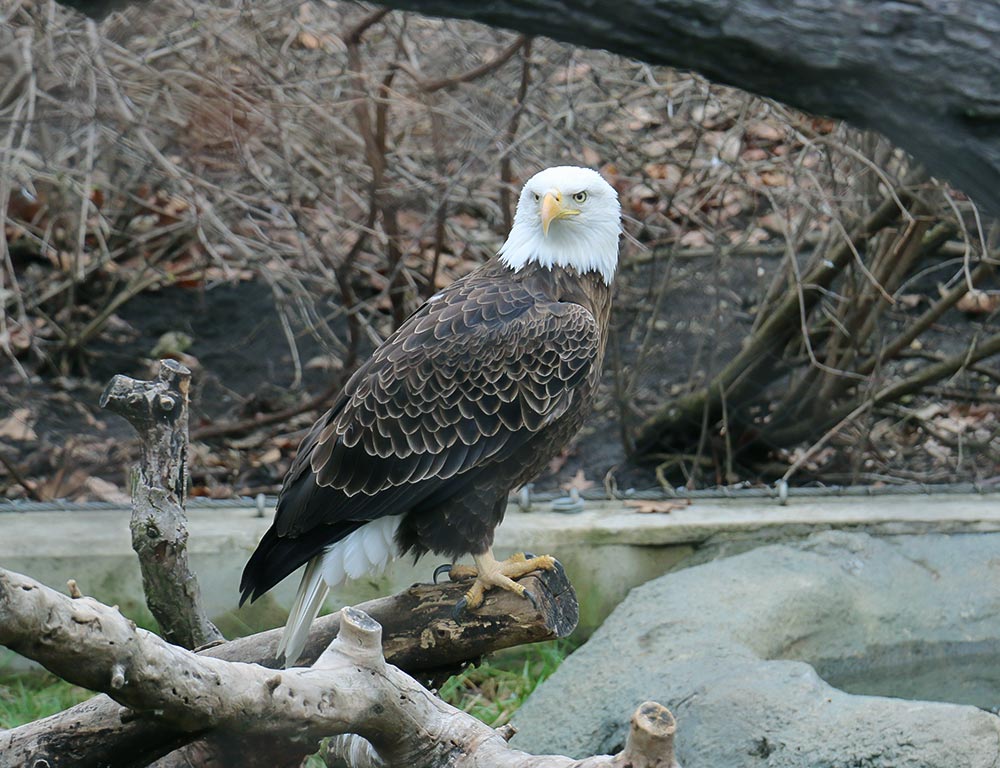
- Scientific Name: Haliaeetus leucocephalus
- Population: Estimated over 300,000 individuals in North America
- Life Span: Up to 28 years
- Size: 70-102 cm (28-40 inches)
- Weight: 3-6.3 kg (6.6-13.9 lbs)
- Food: Fish, waterfowl, small mammals, and carrion
- Wingspan: 178-234 cm (70-92 inches)
- Status: Not globally threatened; Least Concern
The Bald Eagle, an iconic symbol of the United States, is a large bird of prey with distinctive white head and tail feathers. These raptors are often found near large bodies of open water, where they hunt for fish using their sharp talons.
Bald Eagles are also opportunistic scavengers and will feed on carrion. They build large nests in tall trees, and once paired, they often mate for life.
In recent decades, conservation efforts have contributed to the recovery of the Bald Eagle population, and they are no longer listed as an endangered species.
Their successful conservation story is a testament to the impact of conservation measures in preserving iconic species.
5. Steller’s Sea Eagle
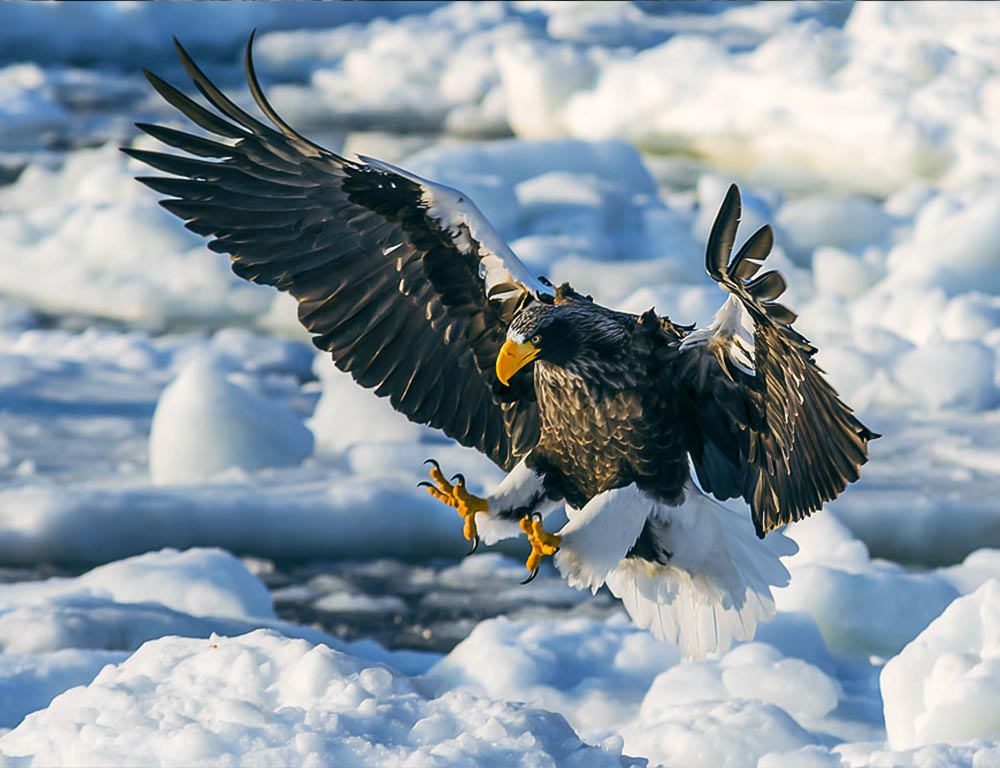
- Scientific Name: Haliaeetus pelagicus
- Population: Estimated around 5,000 to 8,000 individuals
- Life Span: Up to 20-30 years
- Size: 85-105 cm (33-41 inches)
- Weight: 5-9 kg (11-20 lbs)
- Food: Fish, water birds, and small mammals
- Wingspan: 195-245 cm (77-96 inches)
- Status: Near Threatened
Steller’s Sea Eagle is one of the largest and most impressive eagles globally, native to coastal northeastern Asia.
Recognizable by its striking appearance, with a large, powerful beak and distinctive white head, this eagle primarily inhabits coastal areas and large rivers.
Its diet consists mainly of fish, and it is known for its adept hunting skills, diving to snatch fish from the water.
While not directly threatened, Steller’s Sea Eagle faces habitat loss and disturbance challenges. Conservation efforts are essential to ensuring the continued survival of this magnificent bird.
6. Harpy Eagle
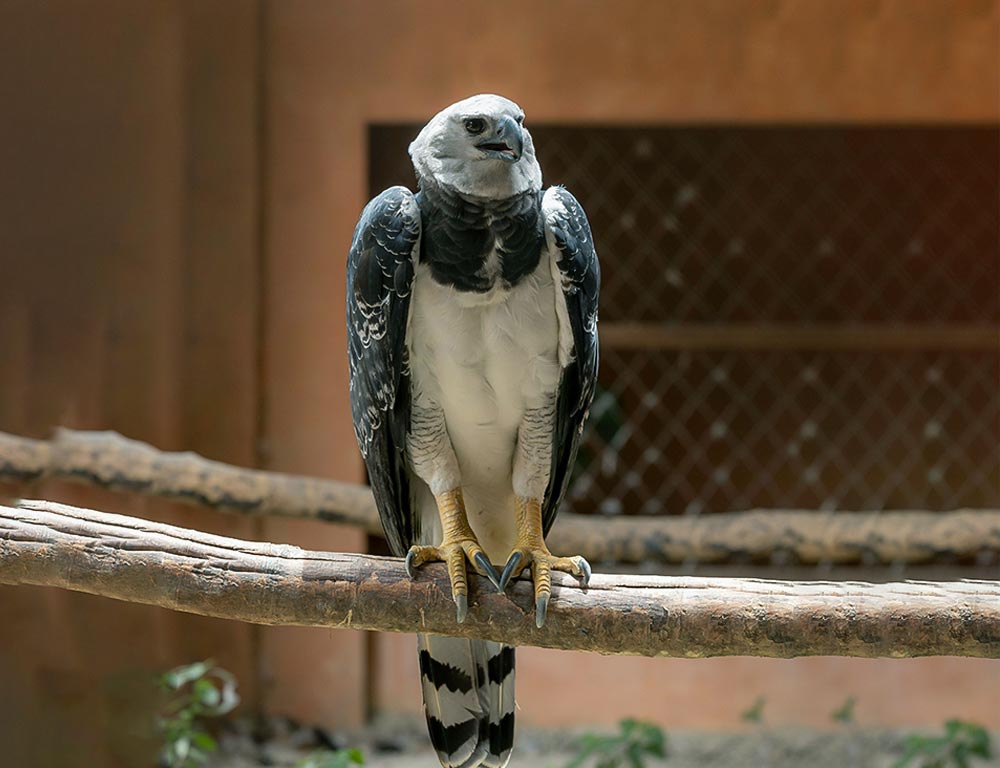
- Scientific Name: Harpia harpyja
- Population: Estimated around 20,000 to 50,000 individuals
- Life Span: Up to 25-35 years
- Size: 86-107 cm (34-42 inches)
- Weight: 4-9 kg (8.8-19.8 lbs)
- Food: Primarily sloths, monkeys, and other tree-dwelling mammals
- Wingspan: 176-201 cm (69-79 inches)
- Status: Near Threatened
The Harpy Eagle, a neotropical species, is one of the world’s largest and most powerful eagles.
Known for its striking appearance and distinctive double crest of feathers on its head, the Harpy Eagle is a forest-dwelling species found in Central and South America.
Unlike fish-eating eagles, the Harpy Eagle’s diet primarily consists of large tree-dwelling mammals, such as sloths and monkeys.
Despite its impressive size and strength, the Harpy Eagle faces habitat loss and hunting threats. Conservation efforts are crucial to protecting the diverse ecosystems where this eagle plays a key role as a top predator.
Why There Are Few Eagle Species in the UK?
The limited presence of eagle species in the United Kingdom can be attributed to historical and geographical factors.
Historically, the UK underwent significant deforestation and habitat transformation over the centuries, leading to the loss of suitable environments for eagles.
Large-scale persecution by humans, driven by concerns over predation on livestock, further contributed to the decline of eagle populations. Geographically, the UK lacks extensive wilderness areas and vast open spaces that are preferred by certain eagle species.
Eagles, being wide-ranging and territorial, require substantial habitats for hunting and nesting, which may not be readily available in the UK’s comparatively smaller and more fragmented landscape.
However, conservation efforts and reintroduction programs have shown promising results in recent years and reestablished populations of specific eagle species in the UK, contributing to the ongoing efforts to restore and protect these magnificent birds of prey.
How Do You Increase the Number of Eagles in The UK?
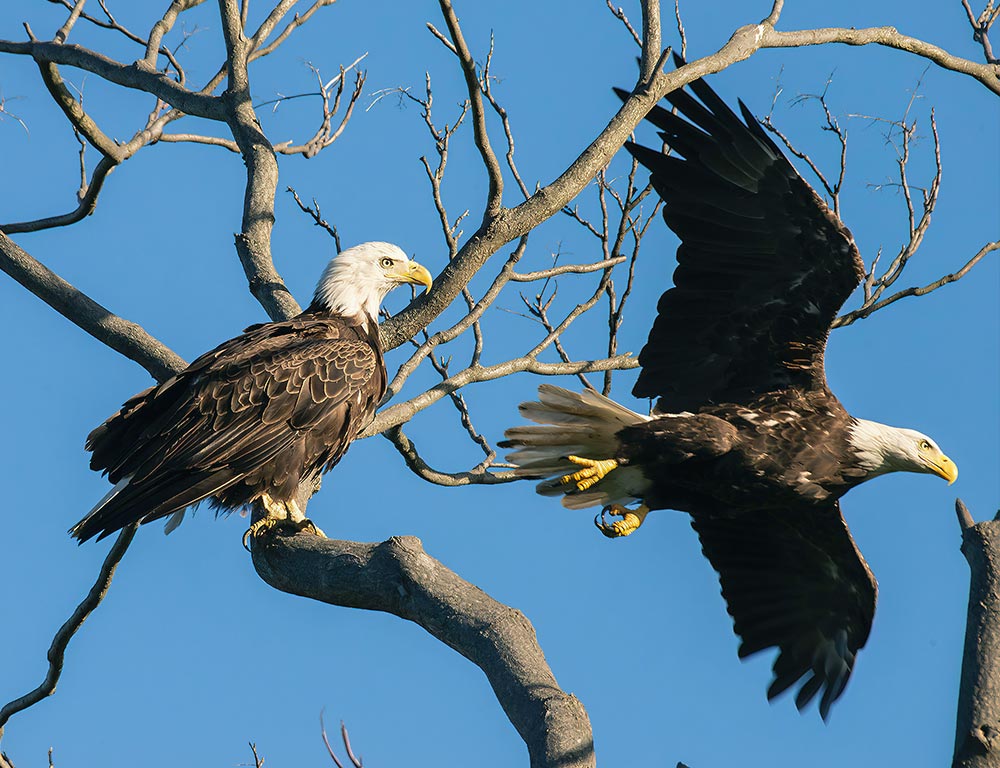
Increasing the number of eagles in the UK involves a multifaceted approach that addresses habitat conservation, mitigation of threats, and active management. Here are key strategies:
Habitat Restoration and Protection
Implementing comprehensive habitat restoration projects and establishing protected areas are crucial for creating suitable environments for eagles.
This involves reforesting and conserving large, undisturbed areas with abundant prey populations, allowing eagles to establish territories and thrive.
Mitigating Human-Wildlife Conflict
Addressing concerns related to human-wildlife conflict is essential.
Implementing effective livestock management practices, such as providing secure enclosures and using non-lethal deterrents, helps minimize conflicts between eagles and local communities, fostering coexistence.
Community Engagement and Education
Engaging local communities through educational programs raises awareness about the importance of eagles in maintaining ecological balance.
Informed communities are more likely to support conservation initiatives and actively participate in protecting eagle habitats.
Reintroduction Programs
Strategically planning and executing reintroduction programs for specific eagle species bolsters populations.
These programs involve carefully releasing captive-bred eagles into suitable habitats and monitoring and ongoing support to ensure successful integration into the wild.
Legislation and Enforcement
Strengthening legal frameworks related to wildlife protection and enforcing anti-poaching measures are vital components of eagle conservation.
Strict penalties for illegal activities, such as nest disturbance and persecution, act as deterrents, creating a safer environment for eagle populations to thrive.
Wrapping Up
The resurgence of eagles in the United Kingdom requires a holistic commitment to habitat conservation, mitigation of threats, and community engagement.
By safeguarding their habitats, addressing human-induced disturbances, and actively managing potential threats, we can pave the way for eagle populations’ majestic return and sustainable growth.
Through ongoing research, collaboration, and international cooperation, the UK can protect these iconic birds and contribute to global efforts in avian conservation.
The success of these endeavours hinges on a collective dedication to fostering a harmonious coexistence between eagles, ecosystems, and the communities that share these landscapes